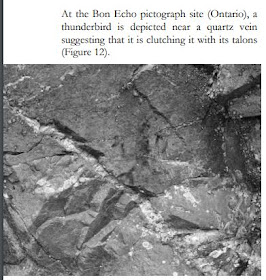by Dagmara Zawadzka (2010)
The Jesuit Pierre Laure has left the
following account of the Antre de Marbre cave in the quartzite outcrop of la
Colline Blanche: “The most remarkable of all the curiosities to
be seen in these woods, in the direction of Nemiskou, is a cave of white
marble, which looks as if a workman had carved and polished it. The aperture is
easy of access, and lights up the interior. The vault corresponds, by its
brilliancy, to its supports. In one corner is a slab of the same substance, but
somewhat rough, which projects, forming a kind of table as if to serve as an
altar. Consequently the savages think that it is a house of prayer and council,
wherein the Spirits assemble. Therefore all do not take the liberty of entering
it; but the jugglers who are, as it were, their Priests, go there in passing to
consult their oracles…”
Global
Rock Art. Annals of the XIV World Congress of the International Federation of
Rock Art Organizations, Piauí, Brazil
(Excerpts:)
“…Substances, such as red stone, quartz, copper,
crystal, shell, and certain woods, such as
birch, were spiritually important and their aesthetic
properties of colour and texture were exploited. The use of exotic stones,
which were traded at a long distance, stems back to
the Paleo-Indian period (10,000-,000 BC)…
The exploitation of the natural shapes and colours of stones is also evinced from the Shin-ga-ba-was-sins, “curiously wrought boulders of rock” that resembles human or animal forms. These stones, which were believed to be imbued with spiritual powers, had sometimes features such as eyes painted in order to accentuate their organic shapes. Certain stones were imbued with special significance. For example, the Mistassini quartzite was called by the Eastern Cree of Québec “Stones that look like fat,” fat being an esteemed substance. Evidence of its exploitation for tools could go back to 4,000 years ago and the quarry itself was regarded as a sacred place...
The exploitation of the natural shapes and colours of stones is also evinced from the Shin-ga-ba-was-sins, “curiously wrought boulders of rock” that resembles human or animal forms. These stones, which were believed to be imbued with spiritual powers, had sometimes features such as eyes painted in order to accentuate their organic shapes. Certain stones were imbued with special significance. For example, the Mistassini quartzite was called by the Eastern Cree of Québec “Stones that look like fat,” fat being an esteemed substance. Evidence of its exploitation for tools could go back to 4,000 years ago and the quarry itself was regarded as a sacred place...
According
to the archaeologist George Hamell (1983), among North-eastern Woodland
Indigenous peoples, substances such as copper and crystal, which can be characterized
as shiny, translucent and light-coloured, are metaphors for Light, Life and Knowledge.
HAMELL (1983: 5) claims that: When consecreated [sic] to ritual use, shell, crystal,
and native copper, and artifacts made from these substances are traditional
material culture expressions of “metaphysics of light” shared by the Northeastern
Woodland Siouans, Algonquians and Iroquoians. Within this metaphysics “Light”
is a metaphorical conceptualization for semantic domains of highest cultural
value or significance: “Life,” “Mind,” “Knowledge,” and “Great Being”. As light,
bright, and white things, shell, crystal, and native copper, are “good to think
(with)…”
These substances, appreciated for their
whiteness, transparency, reflectiveness and lustre, were obtained from
underwater manitous such as the mythical Snake whose body “looked like brass”
and “eyes and horns shone like a mirror.”
White
shiny objects were endowed with special powers. Kohl (1985[1860]: 414-415) recounted a story
relating to the sacredness of white: An Ojibbeway, of whom I inquired why a
white colour was so specially esteemed by the Indians, told me that the cause
was as follows:
“When
the first man on earth fell sick, and saw death before his eyes, he began to
lament and complain to the Great Spirit about the shortness and suffering of
this life. [To help the Great Spirit sent messengers bringing the Midewiwin ].
These messengers brought down at the same time a white hare-skin, the feathers
of a white-headed eagle, and a medicine-sack of white otter-skin. These contained
all the Indian medicines and benefactions of the Great Spirit to mankind. And
from this time forth white became a sacred colour among the Indians…"
“A
Gesamtkunstwerk (German: [gəˈzamtˌkʊnstvɛʁk], translated as "total work of art",
"ideal work of art", "universal artwork", "synthesis
of the arts", "comprehensive artwork", "all-embracing art
form" or "total artwork") is a work of art that makes use of all
or many art forms or strives to do so.”




I was just trying to write about this subject. I remember trying to get info from Doug Harris about the meaning of 'white' and he finally told me that white did not have its own character so much as being an sort of amplifier. So when quartz is used in a rock pile it is more a window from inside to outside the pile.
ReplyDeleteI started singling out some refs to the color White in this one by the same guy, Dagmara Zawadzka "Spectacles to behold: Colours in Algonquian landscapes."
ReplyDeletehttp://ir.lib.uwo.ca/cgi/viewcontent.cgi?article=1113&context=totem
Here you go, thinking about "stones that look like fat" - The intimate bind between colour and substance highlights the importance of the spiritual world which materializes through ritually effective substances (Vastokas 1992:30). The aesthetic of brilliance was exemplified, for instance, by the practice of polishing and rubbing wooden bowls with oil (Philips 1987:89).
ReplyDelete